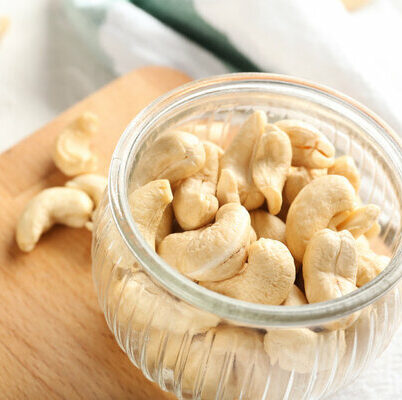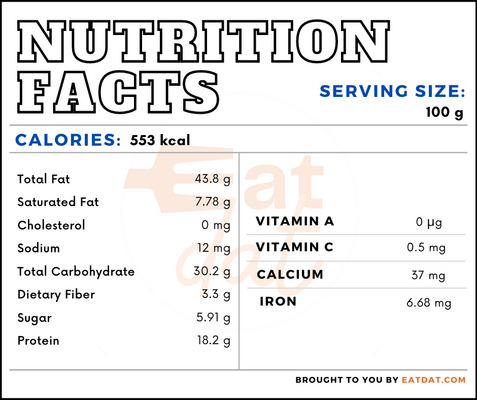
Cashew Nut
What is a Cashew Nut?
Cashew nut is a tree nut harvested from the cashew seeds that hang from the fruit of the cashew apple. The shells are poisonous and, hence, the nuts must be separated with care. The nuts are white in color, covered by a reddish-brown membrane, and have a curvy shape. They have a sweet, nutty, and earthy flavor.
- Cashews are used extensively in preparing curries, stews, soups, desserts, baked goods, and beverages like cashew milk.
- Additionally, they may be made into liquors and are often consumed raw or roasted as a snack.
The top 10 most popular cashew nut brands are:
- Terrasoul Superfoods
- Jiva Organics
- Sunshine Nut Company
- I’m A Nut
- Sincerely Nuts
- Nut Harvest
- Happy Belly
- Planters
- Jaybee’s
- Member’s Mark
Origin of cashew
This nuts are native to Brazil and Venezuela where they have been growing for several centuries. Portuguese colonists brought the nuts to India, where the weather was conducive for their growth. The name originates from the Portuguese word ‘Caju’, referring to the kidney-shape of the nuts. The international cashew nut trade only started in the 1920s. Today, this nut has significantly increased in popularity and is in high demand.
Nutrition
Nutritional profile for cashew nuts (100 g):

Cashew nuts are rich in micronutrients such as magnesium, phosphorus, and potassium. Also, they contain sufficient amounts of calcium, selenium, folate, lutein + zeaxanthin, and vitamin K.
The anti-inflammatory and antioxidant properties of cashew nuts make it a useful tool for fighting inflammatory bowel disorders. Additionally, they offer protection against cardiovascular diseases and inflammation, and may assist in fetus development. Furthermore, the folate and tocopherols found in them help in delaying metabolic disorders and fight arteriosclerosis. However, some people may be allergic to them, which can then trigger severe immune reactions.
Commercial production
The largest producers of cashew nuts are Vietnam, India, Ivory Coast, Philippines, Benin, Tanzania, Guinea-Bissau, Mali, Indonesia, Brazil, Mozambique, and Burkina Faso. Cashews are considered to be a suitable crop for soil conservation, forestation, and wasteland development. They can grow in poor soils but thrive in well-drained sandy loam soil, with a slightly more acidic base. Furthermore, they are a warm climate crop and cannot grow in high altitudes.
First, the nuts are first harvested and then deshelled. Then, they are roasted, dried, peeled, graded, fumigated, before packaging. They must be stored under conditions where it is not exposed to humidity, strong odors, and direct sunlight.
Cashew nut recipes
Cashews are extremely versatile and can be used in a variety of ways. These nuts work well in both sweet and savory dishes. Also, they are used in desserts, soups, main dishes, and salads, and in the form of oil, liqueur, butter, milk, and flour. Additionally, they can be consumed raw, roasted, and salted. Here are some recipes with cashew nut:
- Chicken Korma
- Kaju Curry
- Butter Chicken
- Bolo Polana
- Fonio Salad
- Nkatie Cake
- Basil Cashew Pesto
- Ciabatta
- Vegan Paella
- Cashew Brittle
- Brazilian Christmas Rice
FDA regulations
The FDA regulates cashews as a tree nut and has specific regulations regarding the packaging. In addition, they can be sold as part of mixed nuts, which requires at least four or more different types of nuts in a single package.
References
Molly Melvin, Cashew Nuts | How It’s Made, Food Unfolded Magazine, EIT Food, https://www.foodunfolded.com/article/cashew-nuts-how-its-made
Dias, Celina C Q et al. “Cashew nuts (Anacardium occidentale L.) decrease visceral fat, yet augment glucose in dyslipidemic rats.” PloS one vol. 14,12 e0225736. 12 Dec. 2019, doi:10.1371/journal.pone.0225736, https://www.ncbi.nlm.nih.gov/pmc/articles/PMC6907795/
F. A. Kapinga, L. J. F. Kasuga & E. M. Kafiriti Naliendele, Growth and Production of Cashew Nut, Agricultural Research Institute, Mtwara, Tanzania, https://www.eolss.net/sample-chapters/c10/E1-05A-45.pdf
